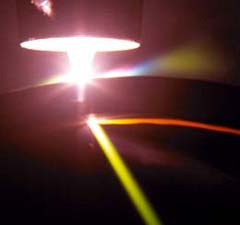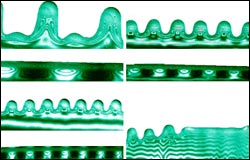This special field revolves around processes for modifying material properties (milling, cooling), composition (filtration, distillation) and type (oxidation, hydration).
Valuable information is available on a broad range of technologies including material separation, laser processes, measuring techniques and robot engineering in addition to testing methods and coating and materials analysis processes.

Inventors at Oxford University have developed a new method to indirectly measure the surface tension of liquid by tracking reflected light intensity to assess the surface configuration. The procedure is reliable, repeatable, quick to set-up and use, contact-less and non-destructive.
Surface tension measurement is an important tool in the characterisation of surface-active liquids and mixtures. Although precise, traditional measuring methods suffer from several problems. With well-established

A new technique to detect localised corrosion in steel and other metals could help industry avoid major repair bills. In some cases, it could even help prevent serious safety problems in industrial plants and other building structures.
This technique differs from traditional methods as it is able to detect corrosion on a much smaller level. This means that preventative action can be taken earlier, saving money, time and possibly lives.
Funded by the Swindon-based Engineering and Ph

Australian scientists have produced a new high-speed welding technology that slashes hours from traditional joining of corrosion-resistant metals.
The Keyhole Welding process has been developed jointly by the Cooperative Research Centre for Welded Structures and CSIRO Elaborately Transformed Metals at Woodville in Adelaide, South Australia.
CSIRO’s Dr Ted Summerville says, ’This is a breakthrough, high-quality solution to the limited penetration of conventional TIG welding’.

Major blackouts such as those that hit North America last week can result from combinations of relatively small problems, such as trees growing too close to powerlines, according to Kevin Cryan, Business Development Manager with CSIRO Mathematical and Information Sciences.
“There seem to have been a number of factors that led to the recent disastrous blackouts but it’s been reported that one incident involved an overheated powerline sagging and making contact with trees,” says Mr Cryan.

New research into jet printing on textiles could lead to a faster, cheaper alternative to conventional ways of dyeing fabrics. Jet printing could also deliver valuable design benefits, such as a wider choice of colours and avoidance of the need to repeat patterns in a design.
The research is being carried out at Leeds University, with funding from the Swindon-based Engineering and Physical Sciences Research Council. Involving a number of industrial partners, the initiative is also bringing t

Reprogammable microarrays
Physicists at the Georgia Institute of Technology have demonstrated a new optical technique for controlling the flow of very small volumes of fluids over solid surfaces. The technique, which relies on changes in surface tension prompted by optically-generated thermal gradients, could provide the foundation for a new generation of dynamically reprogrammable microfluidic devices.
A paper describing the technique is the cover story for the August 1 iss